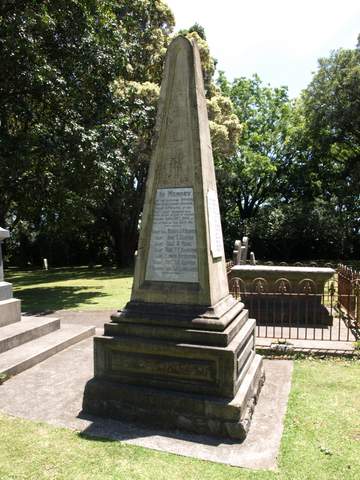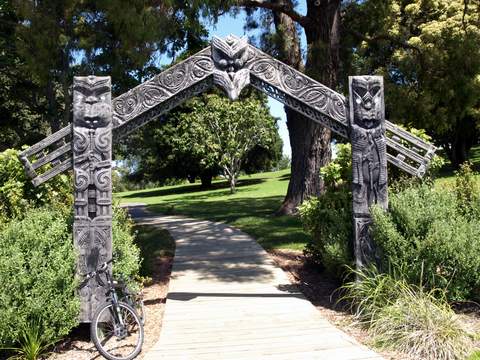1864 - British Army humiliated at Gate Pa

VulcanSpirit
Richard & Alison Brunstrom
Mon 20 Jan 2014 08:10
|
One of the many things I didn't know about Tauranga
was the important part it played in the Maori War of 1864; it was here at the
Battle of Gate Pa (pronounced pah) on 29 April 1864 that the British Army
suffered its biggest defeat in New Zealand - but a defeat notable for the
honour shown by both sides. I found the whole story rather
poignant.
Tauranga was an early mission station, dating from
the late 1830s. The charming 1840s Mission House, known as The Elms,
survives as seen below:
 The Mission occupies high ground looking out over
Tauranga harbour - then a spectacularly beautiful position, but the context has
been all but destroyed by the building of NZ's biggest & busiest port with
associated trunk railway, motorways, and housing, all three of which are now
cheek by jowl with the old Mission. On the night before the battle nine British
officers dined here; only one, a Naval Surgeon, survived.
The Mission had purchased a large amount of land
from local Maori. It was fenced off on a narrow peninsula, with a gate. Some
Maori tribes were incensed by what they saw (rightly) as the British
dispossessing them of their lands in breach of the Waitangi Treaty provisions
and rose in revolt (others stayed 'loyal'). About 250 rebels fortified a small
hillock adjacent to the mission gate by making a 'pa' - an earth and wooden fort
- hence Gate Pa. The British turned up with a force of about 2000 including
modern artillery and opened hostilities in the morning. They fired on the
surrounded pa all day, and at about 4pm launched a joint Navy/Army infantry
assault, entering the pa without significant resistance. However Maori
chiefs had learned from previous encounters with the British and had a very
cunning plan. Their men lay hidden in pits, roofed over, and had been almost
entirely unaffected by the bombardment. They were able to attack the British
from underneath, causing absolute havoc and then panic. The British retreated in
rout suffering casualties of 31 dead and 80 wounded; among the dead were the
Colonel-in-charge of the 43rd Regiment, four of his Captains, the senior Navy
officer and three other officers. Maori lost about thirty dead, but the
remainder slipped away through British lines during the night.
The British dead are buried in the Mission
graveyard, itself on the site of another Maori pa nearby (but one sacked and
destroyed in internecine warfare in 1828). Here is the memorial to the officers
and men of the 43rd Regiment:
 But, unsually, the Maori chief Rawiri Puhiraki is
also interred here:
 He survived the battle of Gate Pa but was killed at
Te Ranga six weeks later with about 80 followers. The monument, erected in 1870
with 'befitting ceremony', explains why he's here. He had published a code of
conduct for the battle of Gate Pa promising humane treatment of wounded and
prisoners to which his warriors adhered scrupulously - one, having escaped the
pa, famously even slipped back through the British lines in the night to
take water to the British wounded who were left out all night.
The British, having been utterly humiliated, soon
extracted their revenge at Te Ranga but then also behaved with surprising
honour, allowing the rebel tribes to lay down their arms and even giving them
food to tide them over the winter in recognition of the fact that they had been
involved in a long campaign. No genocide here. The inscription on Rawiri's
monument pays tribute to his chivalry and credits his actions with creating the
basis for a lasting friendship between Europeans and Maori. It's even
enough to give one hope for mankind, until you read the modern news from
Afghanistan, Syria, Libya, Iraq, South Sudan, the C.A.R. -
or Sandy Hook.
Gate Pa itself is now largely a park (entrance seen
below), with excellent and balanced interpretation (albeit in English only). I
say largely, because it is spoiled by a tacky church on the crest of the hill,
and a major suburban road cutting through one side of it, and it too is now
surrounded by modern life with an enormous Mitre Ten (the NZ version of B&Q,
complete with garish orange corporate colours) right next door, but it's
still possible to get the sense of the site and the huge part that it played in
the history of NZ and British-Maori relations. A thoroughly interesting
place.
 |